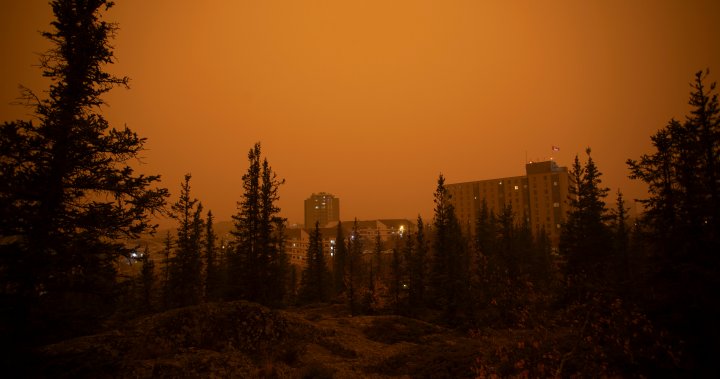Multiple communities in western Canada issued emergency evacuation orders and alerts this weekend due to wildfires, which experts say are more active than expected this time of year.
Thousands of residents in Fort Nelson, British Columbia are currently under an evacuation order as an out-of-control wildfire continues to burn just 3.5 kilometres west of the community, along Highway 97. The order covers surrounding areas and the nearby Fort Nelson First Nation, affecting a total of around 3,500 residents.
Rob Fraser, the Northern Rockies regional municipality mayor, says the wildfire behaviour in northern B.C. this weekend has been “pretty significant.”
“We’ve told people this is their last warning to get out of town,” he told Global News. “It’s starting to get worse.”
A massive swathe of burned forest is seen as a wildfire designated MWF017 by the Alberta Wildfire Service, top right, continues to burn near Ft. McMurray, Alta., in a Saturday, May 11, 2024, handout photo.
THE CANADIAN PRESS/HO-Alberta Wildfire Service
In a Saturday night update, the BC Wildfire Service (BCWS) said the Parker Lake wildfire “experienced significantly reduced fire behaviour” compared to Friday. Reduced wind speeds, cooler temperatures and lingering smoke all helped dampen the fire’s ability to spread, however dry conditions mean the situation could change rapidly.
Fraser said while speaking to Global News Sunday that the fires were relatively calm at the moment, but thick smoke had “effectively blocked out the sun.”

Fort Nelson’s wildfire is still estimated to be around 1,696 hectares.
Alberta experienced similar fire behaviour this weekend, as firefighters battled strong winds in their effort to douse the flames. Friday evacuation orders in Fort McMurray and Saprae Creek were expanded Saturday to include several new surrounding communities.
The email you need for the day’s
top news stories from Canada and around the world.
The Regional Municipality of Wood Buffalo (RMWB) expanded its alert as of 3 p.m. Saturday to include: Fort McMurray, Saprae Creek, Anzac, Fort McMurray First Nation #468, Gregoire Lake Estates and Rickards Landing Industrial Park.
The RMWB said the expanded notice is due to the “risk of wildfire” and means residents must be on alert to leave at a moment’s notice.
An evacuation order was also issued for Grand Prairie County No. 1 on Friday evening due to a wildfire burning about four kilometres east of Teepee Creek that is moving away from the community.
Grand Prairie RCMP issued a release Sunday morning reminding residents to follow evacuation orders.
“Please follow the directions of officers as it is extremely important for your safety, as well as the safety of all first responders,” it said.
Northern Manitoba also faced a dramatic fire scene this weekend. Officials say residents of Cranberry Portage have been safely evacuated, hours after being ordered to leave due to the wildfires.
An evacuation order was issued for the 700-member community Saturday evening after a wildfire burning nearby jumped Highway 10.
Lori Forbes, the emergency measures Coordinator for the RM of Kelsey, said residents have been put up in hotels in The Pas and Swan River, but added that a lack of space means they’re looking to move some people further south.

Tina Colomb, a resident of the First Nations community Pukatawagan, posted a video of Cranberry Portage’s out-of-control flames on social media Saturday evening. She says seeing the fire brought up memories from when her community had been evacuated due to similar circumstances years ago.
“It was insane because the fires were all around our community. We could see the flames and ashes around us. The pines looked like burnt rice on our door steps and grounds,” Colomb told Global News.
“I had a moment of panic and anxiety flare up seeing that fire,” she said, referring to the Cranberry Portage flames.
Fire burning near Cranberry-Portage.
Leeta Charlette-Miller
Fire burning near Cranberry-Portage.
Leeta Charlette-Miller
Officials, experts warry about wildfire severity this summer
Smoke from the numerous wildfires has also been causing reduced visibility and air quality issues in several prairie cities such as Calgary, Edmonton, Saskatoon and Winnipeg.
Government officials warned of potential damage due to warm temperatures and drought. Prime Minister Justin Trudeau on Friday said during a trip to B.C. that Canada needs to be more prepared and coordinated for wildfires this year.
“We know from the forecasts that in western and northern Canada … it is likely to be a very bad forest fire season,” he said. “People are worried what the summer might bring.”
Rhythm Reet, a meteorologist at the Weather Network, says he’s keeping a close eye on how the fires progress across Canada.
“This is quite early in terms of how active they’ve become,” Reet told Global News.
“In the early parts of summer we are possibly going to transition to a neutral setup which can usher in more rain, but as we go into summer we are definitely going to be watching how active this wildfire season gets,” he said.
–with files from Global News’ Eric Stober, Corey Callaghan, Arin Streeter, Lasia Kretzel, Jennifer Ivanov and Amy Judd
© 2024 Global News, a division of Corus Entertainment Inc.





